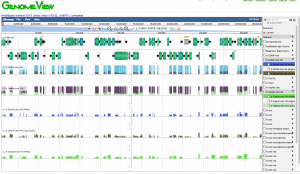Difference between revisions of "Expression Analysis Pipeline"
From CoGepedia
| Line 1: | Line 1: | ||
| + | [[File:Screen_Shot_2014-03-04_at_9.50.01_AM.png|thumb|300px|right|overview of various types of mapping of data from RNASeq]] [[File:Screen Shot 2014-04-07 at 2.27.54 PM.png|thumb|300px|Comparing the results of data mapped with GSNAP versus Tophat/Bowtie2]] | ||
| + | |||
CoGe can generate gene/transcript expression measurements given a FASTQ input and an annotated genome. Thanks to [http://www.skraelingmountain.com/ James Schnable], creator of [http://qteller.com/ qTeller], for help developing this pipeline! | CoGe can generate gene/transcript expression measurements given a FASTQ input and an annotated genome. Thanks to [http://www.skraelingmountain.com/ James Schnable], creator of [http://qteller.com/ qTeller], for help developing this pipeline! | ||
| Line 14: | Line 16: | ||
TBD: how to do this ... | TBD: how to do this ... | ||
| − | + | ||
===Video Tutorial=== | ===Video Tutorial=== | ||
Revision as of 15:35, 7 April 2014
CoGe can generate gene/transcript expression measurements given a FASTQ input and an annotated genome. Thanks to James Schnable, creator of qTeller, for help developing this pipeline!
When a FASTQ file of sequence reads is loaded in LoadExperiment and associated with an annotated genome, the following analysis steps are performed:
- The FASTQ file is verified for correct format.
- CutAdapt is run to trim adapter sequence from the reads (parameters: -q 25 --quality-base=64 -m 17).
- GMAP is run to index the reference genome sequence.
- GSNAP is run to align the reads to the reference sequence (parameters: -n 5 --format=sam -Q --gmap-mode=none --nofails).
- SAMtools is run to compute per-position read depth of the resulting alignment (mpileup -D -Q 20).
- Cufflinks is run to compte per-transcript FPKM (parameters: -p 24).
- The per-position read depth and per-transcript FPKM values are log transformed and normalized between 0 and 1 for loading.
- The three results (raw alignment, per-position read depth, and per-transcript FPKM) are loaded as separate Experiments into a Notebook.
Genomes for which this analysis has been performed can have features imported into qTeller. TBD: how to do this ...
Video Tutorial
- Demo fastq data for Arabidopsis Col-0:
- 0.17M reads: http://de.iplantcollaborative.org/dl/d/2F807292-34CC-4C8E-96E3-3E668A304D23/test_rna_seq_data_0.17M_reads.fastq
- 1M reads: http://de.iplantcollaborative.org/dl/d/EFD4F983-80B1-4388-94C4-AD78E73D2795/test_rna_seq_data_1M_reads.fastq
- 7.6M reads: http://de.iplantcollaborative.org/dl/d/9F6602D6-C66B-4C97-A72A-180AAE55AF95/test_rna_seq_data_7.6M_reads.fastq

